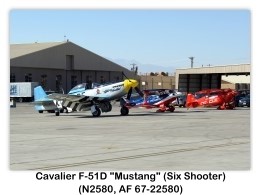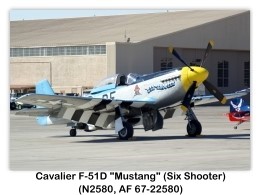
| ||||
|---|---|---|---|---|
 |
 |
 |
 |
 |


























Cavalier F-51D Mustang
Business aircraft/Counter-insurgency aircraft, USA
Archive Photos 1
Cavalier Aircraft F-51D Mustang at the 2000 Torrance Airshow, Zamperini Field, Torrance, CA.
Cavalier Aircraft F-51D Mustang at the Nellis 2007 Airshow, Nellis AFB, Las Vegas, NV.
Overview 2
- Cavalier Mustang
- Role: Business aircraft; Counter-insurgency aircraft
- Manufacturer: Cavalier Aircraft
- First flight: 1958
- Retired: 1984
- Status: Retired
- Number built: 25+
- Developed from: North American P-51 Mustang
- Variants: Piper PA-48 Enforcer
The Cavalier Mustang was a post-World War II civilian-modified version of the North American P-51 Mustang aircraft. Although originally intended as a high speed personal aircraft, the Cavalier was also exported for use as a fighter and close air support aircraft to third world air forces.
Development 2
In 1957, newspaper publisher David Lindsay (1922-2009) formed Trans Florida Aviation Inc. His intention was to transform surplus military P-51s into executive business aircraft. These aircraft were initially called the Trans-Florida Executive Mustang, soon renamed the Trans Florida Aviation Cavalier Mustang. The first of the Executive Mustangs was built in 1958 and for the next few years, only a handful of airframes were built and sold.
To construct the Executive Mustang, Trans Florida purchased military surplus P-51s. The airframes were completely disassembled, the military equipment stripped out, and then rebuilt with a second seat, new avionics, plush leather interiors, luggage bays and civilian paint schemes. By 1961, the aircraft were renamed Cavalier 2000, referring to the 2,000-statute-mile (3,200 km) range. Five different Cavalier models were eventually offered: the Cavalier 750, 1200, 1500, 2000 and 2500, differing in fuel capacity, with the name indicating the approximate range of the aircraft. Over the course of the next decade, nearly 20 of these aircraft would be constructed. Several FAA approved modifications to the Cavalier design would be made during that time, including canopy frame mounted cockpit fresh air vents, 96-US-gallon (360 L; 80 imp gal) wingtip fuel tanks, fuselage baggage door, 60 gallon ammo/gun bay fuel tanks, and a 14-inch (360 mm) taller vertical stabilizer.
Between 1964 and 1965, Trans Florida completed an IRAN inspection of over 30 F-51Ds of the Dominican Air Force (FAD) in Sarasota.
In 1967 the company was renamed Cavalier Aircraft Corporation.
Military Cavaliers 2
Cavalier F-51D
In 1967, a decade after creating their first civilian P-51 conversion, Trans Florida was contracted by the United States Department of Defense to create military specification F-51Ds for export. These military aircraft incorporated most of the improved features of the civilian Cavaliers but were optimized as ground attack fighters. These aircraft were called Cavalier F-51D Mustangs; nine single control (F-51D) and two dual-control (TF-51D) aircraft were built. The aircraft were given new 67-

| ||||
|---|---|---|---|---|
 |
 |
 |
 |
 |



























| ||||
|---|---|---|---|---|
 |
 |
 |
 |
 |


























Cavalier Mustang II
In 1967, Cavalier developed an outgrowth of the F-51D designed for close air support and counter-insurgency operations, calling this aircraft the Cavalier Mustang II. The Mustang II had improved avionics, structural improvements to the wing to allow more external weapons carriage on four additional hardpoints and an improved Rolls-Royce Merlin V-1650-724A engine.
Two batches of Mustang IIs were constructed: the first group was built for El Salvador in 1968 and the second group was constructed for export to Indonesia in 1972 and 1973. The five Mustang IIs (including one TF-51D) built for El Salvador featured wingtip fuel tanks to increase combat range. Five Mustang IIs and one TF-51D were built for Indonesia in 1972, but they did not have tip tanks due to a U.S. State Department restriction on their combat radius.
Cavalier Turbo Mustang III/Enforcer
In 1968, Cavalier mated a Rolls-Royce Dart 510 turboprop to a Mustang II airframe. This privately funded prototype was also intended for the same CAS/COIN mission that the Mustang II was built for. The Turbo Mustang III had radically increased performance, along with an associated increase in payload and decrease in cost of maintenance due to the turbine engine. Despite numerous sales pitches to the United States Air Force, neither the U.S. military nor any foreign operators purchased the Turbo Mustang III. Seeking a company with mass production capability, the Turbo Mustang prototype, now called "The Enforcer," was sold by Lindsay to Piper Aircraft in 1971.
Cavalier Aircraft Corp. was closed in 1971 so the founder/owner, David Lindsay, could help develop the Piper PA-48 Enforcer. Lindsay set up a new company, Field Services Inc., to complete a Cavalier Mustang II contract for Indonesia. Many of the civil Mustang conversions, as well as many re-imported former military Cavaliers, have been restored into P-51Ds and fly on the U.S. and European air show circuits today.
Piper PA-48 Enforcer
In 1968, Cavalier Aircraft owner/founder David Lindsay began developing a highly modified version of the Cavalier Mustang for use as a counter-insurgency aircraft. Cavalier initially mated a Rolls-Royce Dart 510 turboprop to a Mustang II airframe. This privately funded prototype was also intended for the same CAS/COIN mission that the Mustang II was built for. The Turbo Mustang III had radically increased performance, along with an associated increase in payload and decrease in cost of maintenance, and was equipped with Bristol ceramic armor to protect the engine, airframe and pilot. Despite numerous sales attempts to the United States Air Force, neither the U.S. military nor any foreign operators purchased the Turbo Mustang III.
Seeking a company with mass production capability, the Turbo Mustang III, renamed the "Enforcer," was sold to Piper Aircraft in late 1970. Cavalier Aircraft Corp. was closed in 1971 so the founder/owner, David Lindsay, could help continue develop the Enforcer concept with Piper. Piper was able to lease a Lycoming T-55L-9 engine from the USAF (the engine Lindsay wanted initially) and flew the aircraft some 200+ hours. In 1984 with a $US12 million appropriation from Congress, Piper built two new Enforcers, giving the new prototypes the designation PA-48. These aircraft were evaluated by the USAF, but flown only by Piper test pilots.
In 1971, Piper built two Enforcers by heavily modifying two existing Mustang airframes, fitting them with Lycoming YT55-L-9A turboprop engines along with numerous other significant modifications. One airframe was a single seat (called the PE-1 and FAA registered as N201PE), the other a dual-control aircraft (the PE-2, registered N202PE). Prior to the Pave COIN evaluation, N202PE was lost in a crash off the Florida coast on 12 July 1971 due to flutter caused by a Piper-modified elevator trim tab. Although the Enforcer performed well in the 1971-1972 Pave COIN test flown by USAF pilots, Piper failed to secure a USAF contract.
Specifications (Cavalier F-51D) 2
General Characteristics
- Crew: One
- Length: 34 ft 2 in (10.40 m)
- Wingspan: 41 ft 4 in (with Tip Tanks) (12.60 m)
- Height: 13 ft 1 in (4.00 m)
- Wing area: 408 ft² (37.9 m²)
- Loaded weight: 12,000 lb (6,350 kg)
- Powerplant: 1 × Rolls-Royce Merlin 724 Hamilton Standard four blade HS hydromatic, 1,720 shp (1,831 kW)
Performance
- Max speed: 440 mph (708 km/h)
- Range: 2,000 miles (3,218 km)
- Service ceiling: 41,000 ft (11,465 m)
- Rate of climb: 3,000 ft/min (m/s)
- Wing loading: 34 lb/ft² (167 kg/m²)
- Power/mass: 0.18 hp/lb (0.29 kW/kg)
Armament
- Hardpoints: Six underwing hardpoints for a variety of stores and 6 0.50 cal (12.7 mm) machine guns
References
- Shupek, John. Photos via The Skytamer Archive, copyright (Photos by John Shupek) copyright © 2000 and 2007 Skytamer Images (Skytamer.com))
- Wikipedia, the free encyclopedia. Cavalier Mustang


